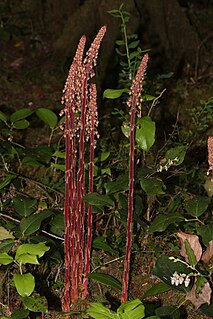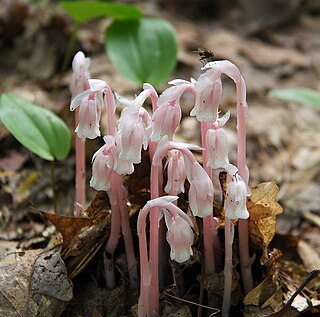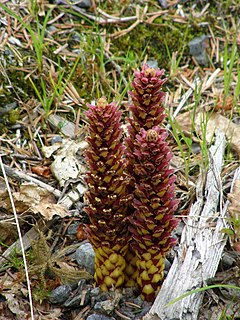
The plastid is a membrane-bound organelle found in the cells of plants, algae, and some other eukaryotic organisms. They are considered to be intracelluar endosymbiotic Cyanobacteria. Examples include chloroplasts, chromoplasts, and leucoplasts.

The Aristolochiaceae are a family, the birthwort family, of flowering plants with seven genera and about 400 known species belonging to the order Piperales. The type genus is Aristolochia L.

Orobanchaceae, the broomrapes, is a family of mostly parasitic plants of the order Lamiales, with about 90 genera and more than 2000 species. Many of these genera were formerly included in the family Scrophulariaceae sensu lato. With its new circumscription, Orobanchaceae forms a distinct, monophyletic family. From a phylogenetic perspective, it is defined as the largest crown clade containing Orobanche major and relatives, but neither Paulownia tomentosa nor Phryma leptostachya nor Mazus japonicus.

Pterospora, commonly known as pinedrops, woodland pinedrops, Albany beechdrops, or giant bird's nest is a North American genus in the subfamily Monotropoideae of the heath family, and includes only the species Pterospora andromedea. It grows in coniferous or mixed forests. It is widespread across much of Canada as well as the western and northeastern United States to and northern Mexico. Along with Monotropa it is one of the more frequently encountered genera of the Monotropoideae.

Hydnoroideae is a subfamily of parasitic flowering plants in the order Piperales. Traditionally, and as recently as the APG III system it given family rank under the name Hydnoraceae. It is now submerged in the Aristolochiaceae. It contains two genera, Hydnora and Prosopanche:

The Rafflesiaceae are a family of rare parasitic plants comprising 36 species in 3 genera found in the tropical forests of east and southeast Asia, including Rafflesia arnoldii, which has the largest flowers of all plants. The plants are endoparasites of vines in the genus Tetrastigma (Vitaceae) and lack stems, leaves, roots, and any photosynthetic tissue. They rely entirely on their host plants for both water and nutrients, and only then emerge as flowers from the roots or lower stems of the host plants.

Myco-heterotrophy is a symbiotic relationship between certain kinds of plants and fungi, in which the plant gets all or part of its food from parasitism upon fungi rather than from photosynthesis. A myco-heterotroph is the parasitic plant partner in this relationship. Myco-heterotrophy is considered a kind of cheating relationship and myco-heterotrophs are sometimes informally referred to as "mycorrhizal cheaters". This relationship is sometimes referred to as mycotrophy, though this term is also used for plants that engage in mutualistic mycorrhizal relationships.

A parasitic plant is a plant that derives some or all of its nutritional requirement from another living plant. They make up about 1% of angiosperms and are found in almost every biome. All parasitic plants have modified roots, called haustoria, which penetrate the host plant, connecting them to the conductive system – either the xylem, the phloem, or both. For example, plants like Striga or Rhinanthus connect only to the xylem, via xylem bridges (xylem-feeding). Alternately, plants like Cuscuta and Orobanche connect only to the phloem of the host (phloem-feeding). This provides them with the ability to extract water and nutrients from the host. Parasitic plants are classified depending as to the location where the parasitic plant latches onto the host and the amount of nutrients it requires. Some parasitic plants are able to locate their host plants by detecting chemicals in the air or soil given off by host shoots or roots, respectively. About 4,500 species of parasitic plant in approximately 20 families of flowering plants are known.

Cuscuta campestris, with the common names field dodder, golden dodder, large-seeded alfalfa dodder, yellow dodder and prairie dodder, is a parasitic plant which belongs to the family Convolvulaceae. It was formerly classified in the family Cuscutaceae.
Chromera velia, also known as a "chromerid", is a unicellular photosynthetic organism in the superphylum Alveolata. It is of interest in the study of apicomplexan parasites, specifically their evolution and accordingly, their unique vulnerabilities to drugs.

Orobanche minor, the hellroot, common broomrape, lesser broomrape, small broomrape or clover broomrape, is a holoparasitic flowering plant belonging to the genus Orobanche; a genus of about 150 non-photosynthetic plants that parasitize other autotrophic plants.

Mitrastemon is a genus of two widely disjunct species of parasitic plants. It is the only genus within the family Mitrastemonaceae. Mitrastemon species are root endoparasites, which grow on Fagaceae. It's also a non-photoysthetic plant that parasitizes other plants such as Castanopsis sieboldii. The parasitic plant was first discovered by botanist Eizi Matuda during an expedition to Mt. Ovando in the state of Chiapas, Mexico. The different species were originally named by a friend of Matuda, Yamamoto in 1925–1926. Mitrastemon yamamotoi is a protandrous plant. Its flowers go through a male phase before transforming into their final female form. The flowers of M. yamamotoi attract a variety of insects ranging from wasps to flies and beetles. Among these, beetles are the best pollinators for this plant since their visit to the flower would pick up a large amount of pollen and they would pollinate from each of the flowers that they had already visited. The plant is endemic to tropical and subtropical forest regions such as Southeast Asia and Japan.
Vitrella brassicaformis is a unicellular alga belonging to the eukaryotic supergroup Alveolata. V. brassicaformis and its closest known relative, Chromera velia, are the only two currently described members of the phylum Chromerida, which in turn constitutes part of the taxonomically unranked group Colpodellida. Chromerida is phylogenetically closely related to the phylum Apicomplexa, which includes Plasmodium, the agent of malaria. Notably, both V. brassicaformis and C. velia are photosynthetic, each containing a complex secondary plastid. This characteristic defined the discovery of these so-called 'chromerids,' as their photosynthetic capacity positioned them to shed light upon the evolution of Apicomplexa's non-photosynthetic parasitism. Both genera lack chlorophyll b or c; these absences link the two taxonomically, as algae bearing only chlorophyll a are rare amid the biodiversity of life. Despite their similarities, V. brassicaformis differs significantly from C. velia in morphology, lifecycle, and accessory photosynthetic pigmentation. V. brassicaformis is green, with a complex lifecycle involving multiple pathways and a range of sizes and morphologies, while Chromera is brown and cycles through a simpler process from generation to generation.

Boschniakia rossica, commonly known as the northern groundcone, is a holoparasitic plant that lives in the northern latitudes of the northern hemisphere. In the Pacific Northwest Temperate Rainforest, it does not grow south of Prince of Wales Island, beyond that boundary is the Vancouver groundcone habitat. It does not contain chlorophyll, so it must be parasitic to obtain nutrients. It specializes on Alnus species, but can parasitize off of other trees and shrubs such as on Betula (birch), Salix (willow), Vaccinium (blueberry), Picea (spruce), and Chamaedaphne. This organism is likely to be found at mid elevations alongside rivers and streams, where moisture is abundant. This species propagates itself through water flow. In some places bears are known to have eaten the starchy roots, or tubers, of this plant.
The evolution of photosynthesis refers to the origin and subsequent evolution of photosynthesis, the process by which light energy synthesizes sugars from carbon dioxide and water, releasing oxygen as a waste product. The process of photosynthesis was discovered by Jan Ingenhousz, a Dutch-born British physician and scientist, first publishing about it in 1779.

Hydnora is a group of parasitic plants described as a genus in 1775. It is native to Africa, Madagascar, and the Arabian Peninsula.
Hydnora visseri, the Visser's hydnora, is a subterranean holoparasitic plant, lacking leaves and roots, and is described from southwestern Namibia and northwestern South Africa and has the longest tepal lobes of all Hydnora species. The genus Hydnora is composed entirely of holoparasitic plants that attach to the root of their hosts and are restricted to Africa and southwestern Asia.
Jeffrey Donald Palmer is a Distinguished Professor of Biology at Indiana University Bloomington.

Daniel Lee Nickrent is an American botanist, working in plant evolutionary biology, including the subdisciplines of genomics, phylogenetics, systematics, population genetics, and taxonomy. A major focus has been parasitic flowering plants, particularly of the sandalwood order (Santalales). His interest in photographic documentation and photographic databases has led to several photographic databases including Parasitic Plant Connection, Phytoimages, Plant Checklist for the Rocky Mountain National Park, and Plant Checklist for the Crab Orchard National Wildlife Refuge.















